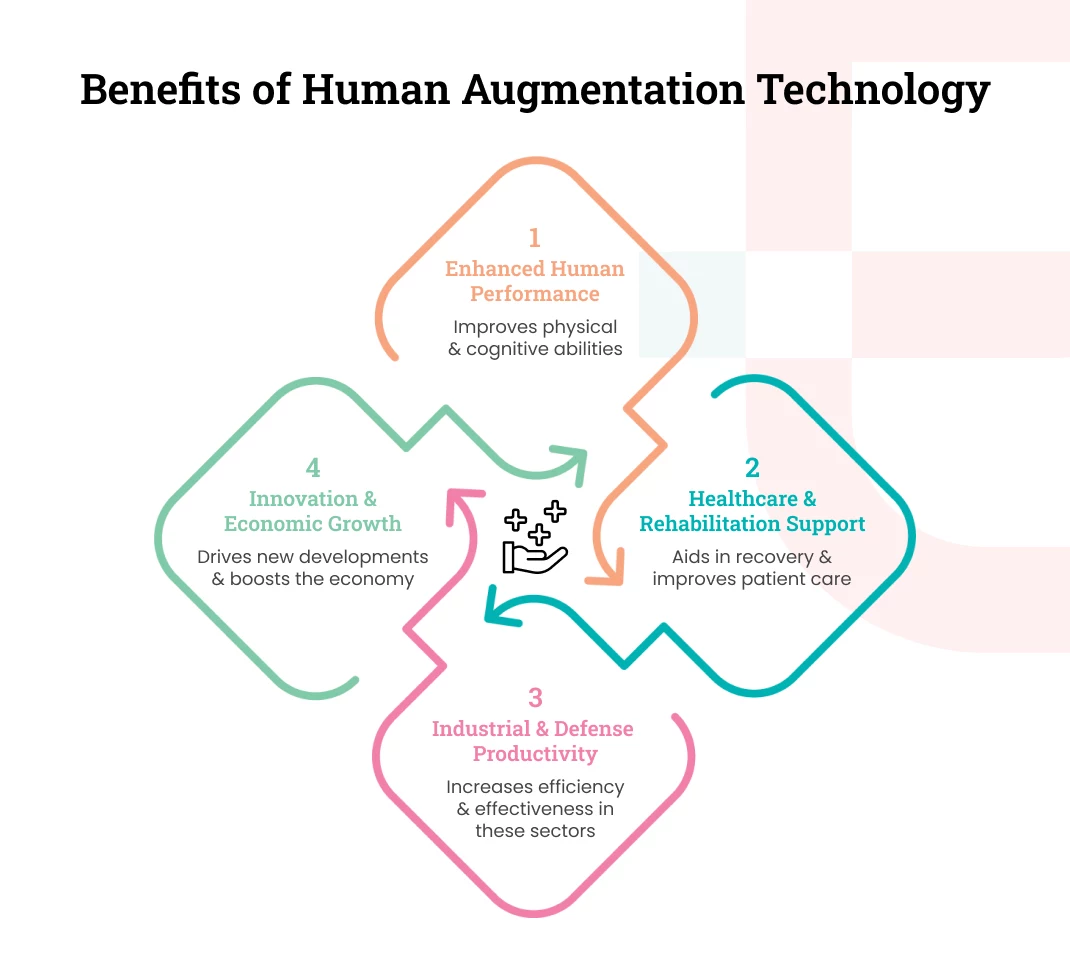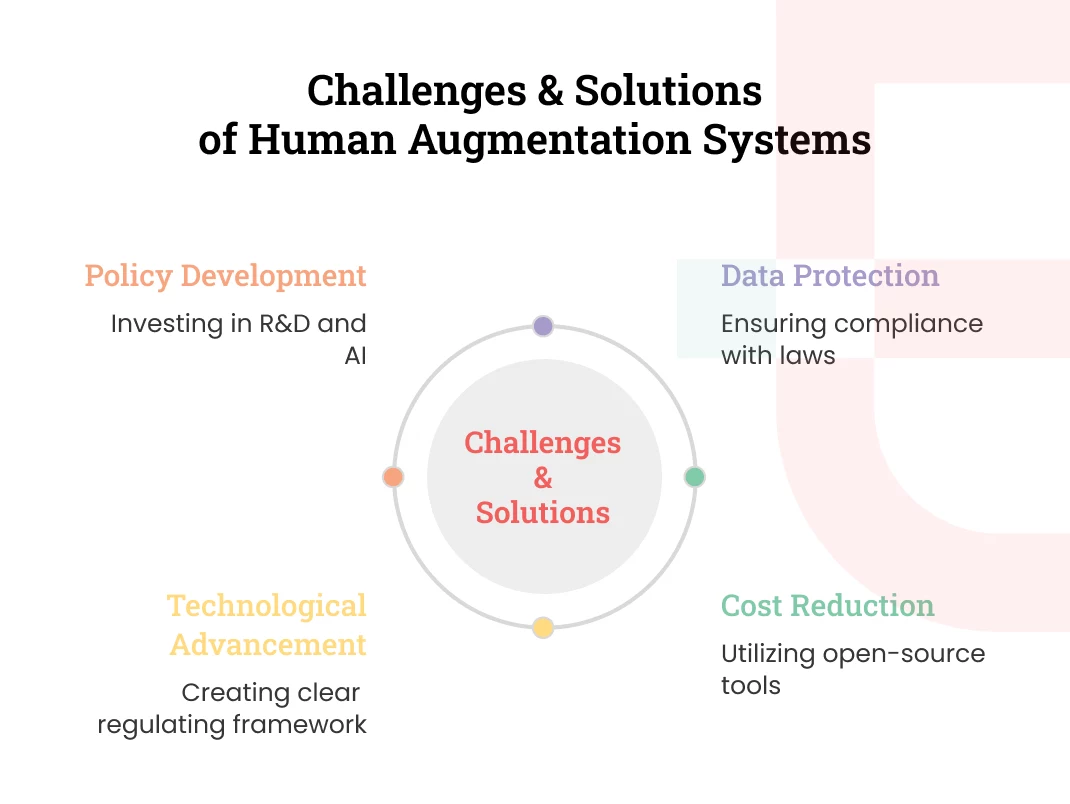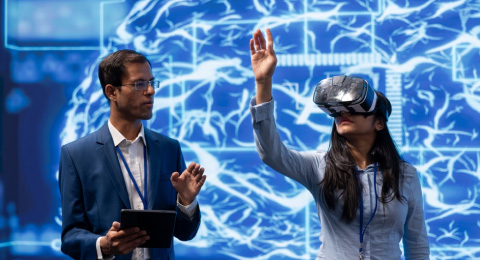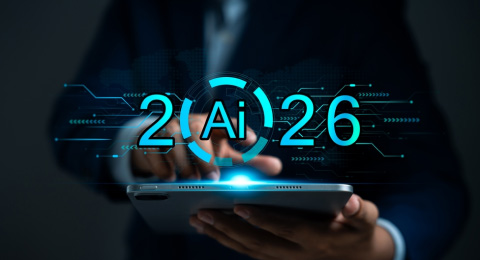
Human augmentation technology is quickly emerging as one of the most transformative innovations of our time. It is blurring the line between humans and machines. From AI-powered prosthetics to robotic exoskeletons and neural interfaces, it is redefining what humans can achieve.
Besides improving physical and cognitive abilities, it is also creating a whole new path for business innovation. In this article, we’ll explore how human augmentation works, its benefits, challenges, and future prospects shaping tomorrow’s tech-driven world.
Understanding Human Augmentation Technology
Human augmentation is a technology to improve human capabilities to overcome certain physical and mental challenges. For that, it combines biology, engineering, and artificial intelligence through advanced tools like sensors, robotics, and neural interfaces.
Cochlear implants or robotic limbs are some of the best applications of this technology. AI-powered assistants that boost mental performance also represent one of the applications of human augmentation.
Human augmentation technology can be divided into the following three types based on its area of application:
Physical Augmentation
Physical augmentation refers to the application of human augmentation to improve the body strength or movement of the user. For example, robotic exoskeletons are based on this technology. They provide mobility support to patients with paralysis.
Sensory Augmentation
This type of human augmentation improves or replaces human senses. Tools, like smart glasses, that enhance how we sense the world, make use of sensory augmentation technology. It can also be used for developing new senses, like using AR to improve vision for patients with limited eyesight.
Cognitive Augmentation
Human augmentation technology can improve our cognitive power as well. ChatGPT is the perfect example. It can summarize information or generate ideas that significantly improve the user’s ability to complete tasks faster.
Usually, human augmentation is considered a means to fix physical disabilities. Rather, it’s all about using technology to push human limits to achieve things beyond the normal capacity.
Benefits of Human Augmentation Technology

Physical AI will remain one of the top AI trends for intelligent automation. It connects smart machines with the real world. It uses sensors, cameras, and robotics to see, decide, and act. It powers warehouse robots, delivery drones, and surgical tools. Let’s take a look at some major benefits of this technology on different aspects of human life and the business world in general.
Improving Human Performance
Human augmentation creates a connection between our brain and a supportive device to help us go beyond our natural limits. While robotic exoskeletons improve endurance, smart glasses display real-time data to aid surgeons and pilots. The technology holds the potential to improve the speed and accuracy of humans when used judiciously.
Supporting Healthcare and Rehabilitation
One of the major challenges in the healthcare sector is to help patients restore their normal physical abilities after certain medical conditions. In this regard, human augmentation is a blessing for humankind.
With this technology, amputees can restore natural movement and control through prosthetic limbs. These artificial limbs respond to nerve signals and help patients restore lost abilities.
Driving Industrial and Defence Productivity
Human augmentation is slowly getting a wide application in the industrial and defense sectors. The technology has proved itself useful to enhance the productivity and safety of workers in many ways.
For instance, many manufacturing plants are using exoskeletons. These are mechanical suits powered by human augmentation to help workers lift heavy loads to reduce muscle fatigue. Similarly, AR helmets are helping soldiers to view tactical data during missions and operate well in extreme conditions.
Fostering Innovation and Economic Growth
Because of its capacity to lead innovation in human capacity building, human augmentation is fostering economic growth. Its global market will surpass $385.9 billion by 2027. There will be revolutions in wearable technologies, robotics, and AI integration. That means more employment in design, bioengineering, and cybernetics.
Next, let’s look at some popular applications of human augmentation technology across different sectors.
Step into the Future of Human-Machine Collaboration. Schedule a Free Consultation With Our AI Development Team Today.
Use Cases of Human Augmentation Technology

Human augmentation has already started benefiting different sectors, as shown below.
Healthcare and Medical Rehabilitation
- Through bionic arms and neural prosthetics, amputees are able to restore movement by regaining control over the muscle or nerve signals.
- Doctors are leveraging wearable biosensors to get the health vitals of patients in real-time to offer personalized treatment.
- Exoskeletons are becoming a ray of hope for patients to recover from spinal injuries or strokes.
Military and Defence
- Soldiers are using performance exosuits to have more strength and endurance during field operations.
- Cognitive enhancement tools are helping soldiers sharpen focus, situational awareness, and decision-making under stress.
- Real-time battlefield analytics powered by AI and AR are fetching instant tactical information to improve mission accuracy and safety.
Education and Learning Enhancement
- AR and VR platforms are helping businesses to create immersive learning environments for medical, engineering, or technical training.
- Field researchers are leveraging cognitive augmentation apps to improve their memory and become creative in their studies.
- Training materials are getting highly personalized with AI to yield the best engagement and outcomes.
Manufacturing and Logistics
- Human-robot collaboration systems are allowing workers to safely interact with robotic arms for precision tasks.
- Lifting aids and powered suits are reducing strain and workplace injuries in heavy-duty operations.
- Fatigue reduction tools are monitoring worker health and optimizing shifts to improve productivity and safety in industrial settings.
However, despite all these advances, like any other technology, human augmentation also has its fair share of challenges to deal with.
Challenges and Solutions of Human Augmentation Systems

Human augmentation is full of potential. Yet it is not free from complex challenges that delay its widespread acceptance and safety. Let’s see what they are and how to address them.
Ethical and Privacy Issues
For the technology to work properly, it has to collect sufficient brain and body data. That raises ethical concerns. For example, what if the neural signals collected by a brain-computer interface are subjected to misuse?
Solution:
Organizations dealing with human augmentation systems should abide by data protection frameworks. Governments should also enforce strict privacy laws for user consent, data encryption, and transparent research practices.
Cost and Scalability Constraints
Working around human augmentation systems involves a massive production and maintenance cost. For example, not all patients can afford advanced prosthetics that cost thousands of dollars. The same is the case with exoskeletons, restricting their mass adaptation.
Solution:
There are different ways to cut down the cost. For example, open-source innovations reduce the cost of scalability to a great extent. Public-private partnerships and government subsidies can further diffuse the risk and cost challenges for small businesses trying to do some great innovations in AI human augmentation systems.
Regulatory and Social Acceptance Hurdles
Looking at the benefits of human augmentation, the technology moves faster than regulations can keep up. Currently, there are a few governing bodies that regulate this technology. This is also slowing down public adoption and new innovations.
Solution:
The concerned governments of all countries should take the lead to act as the catalyst for new innovations. They should build transparent policies and strong ethical compliance labels. This will create a positive ground of collaboration between scientists, ethicists, and technology companies.
Technological and Safety Limitations
Despite rapid progress, human augmentation technology faces many technical challenges. For example, there is no such development yet on how to reduce the size of exoskeletons that feel comfortable to use for long hours. Then there are power limitations, cybersecurity threats, and data transmission delays. These factors can further compromise safety.
Solution:
There are two things to focus on to overcome these challenges: continuous R&D and repeated testing. Leveraging AI-driven diagnostics can further help to detect and address faults early.
Companies Using Human Augmentation Technology
Many notable companies around the world have already begun leveraging human augmentation in their working process. Let’s take a look at some popular inspirations.
1. Johnson & Johnson (Healthcare)
The surgeons at J&J are using Microsoft HoloLens, a type of AR headset, to improve surgical precision. These headsets have cameras and sensors to track the patient’s position as per the surgeon’s head movements. Then it displays typical information like vital signs and CT scan reports directly on top of the patient.
2. Ford (Manufacturing)
Ford has been using exoskeletons since 2018 to support workplace fatigue in its plants. As of now, it is using upper-body exoskeletons, also known as EksoVest, for employees in 15 plants globally. For this, the company has partnered with Ekso Bionics, a leading manufacturer of exoskeleton bionic devices.
3. DHL (Aerospace)
DHL, the world’s leading logistics company, has been beta testing smart glasses and augmented reality in a warehouse in the Netherlands. The aim is to implement ‘vision picking’ in warehousing operations. The smart glass will guide staff through the warehouse with graphics to speed up the picking process and reduce errors. It has proved to increase the picking process efficiency by 25%.
The Future of Human Augmentation Technology
The future of human augmentation is rapidly evolving through groundbreaking technologies. Let’s explore its potential growth in the near future.
Integration with AI, Robotics, and Quantum Computing
The AI human augmentation will get into advanced applications with the help of robotics and quantum computing. For example, hybrid quantum-classical systems are now undergoing experiments to process huge amounts of data in real time. Its success will power “smart” exoskeletons to not only restore lost abilities but also develop entirely new ones.
The Rise of Transhumanism and Human-AI Symbiosis
The AI human augmentation is steering the movement toward transhumanism. This is the idea of transcending human biological limits through technology. Through this development, AI can be embedded into human cognition to improve decision-making, perception, and even consciousness.
What It Means for Startups and Industry Leaders
There will be a huge opportunity for startups and industry leaders to lead neurotech platforms, robotic wearables, and biotech innovations. Of course, there will still be challenges in securing user trust. Ethical and regulatory challenges will be there too. However, those who master these will set the standards for the next wave of human capability.
Conclusion
Human augmentation technology is a bold step towards the bright future of humankind. With the power of AI, robotics, and biotechnology in their hands, businesses have a unique chance to redefine human potential. However, it is imperative to adapt to this shift responsibly with the right strategy. Partnering with a reliable AI development services company can help entrepreneurs scale augmentation systems ethically.
It’s time to harness the power of this powerful technology to drive sustainable growth.
FAQs
Human augmentation is a technological advancement to amplify human abilities, whether physical, sensory, or cognitive. This fusion of human and machine is made possible by the use of devices, sensors, and AI systems that amplify our capabilities. This is helping people to surpass their own capabilities in work, health, and everyday life.
Human augmentation systems include sensors, actuators, AI processors, and interfaces. Sensors detect body or brain signals, actuators turn them into motion, and AI processes the data to respond intelligently. The interface connects the human body with the device, enabling smooth interaction and control.
AI makes human augmentation smarter and more responsive. It studies body signals to predict movements or actions. In prosthetics, AI adjusts grip strength automatically. In cognitive tools, it boosts memory, focus, and decision-making, making technology work seamlessly with human intent.
The cost of development of human augmentation systems depends on the degree of complexity, the state of the technology, and the application. Basic wearables and assistive devices could cost anything from $50,000 to $200,000 to design, test, and roll out. However, advanced exoskeletons or mind-computer interfaces can have an R&D price tag that goes over $1 million. Hardware development, AI integration, safety testing, and following regulatory guidelines are all part of the expenses.
When it comes to the moral ramifications of human augmentation, a lot of concerns are raised in relation to privacy, fairness, and autonomy. Using a person’s brain or physiological data without consent is basically an invasion of privacy. The question of who owns the data is also an issue. It blurs the line between personal choice and machine control.









